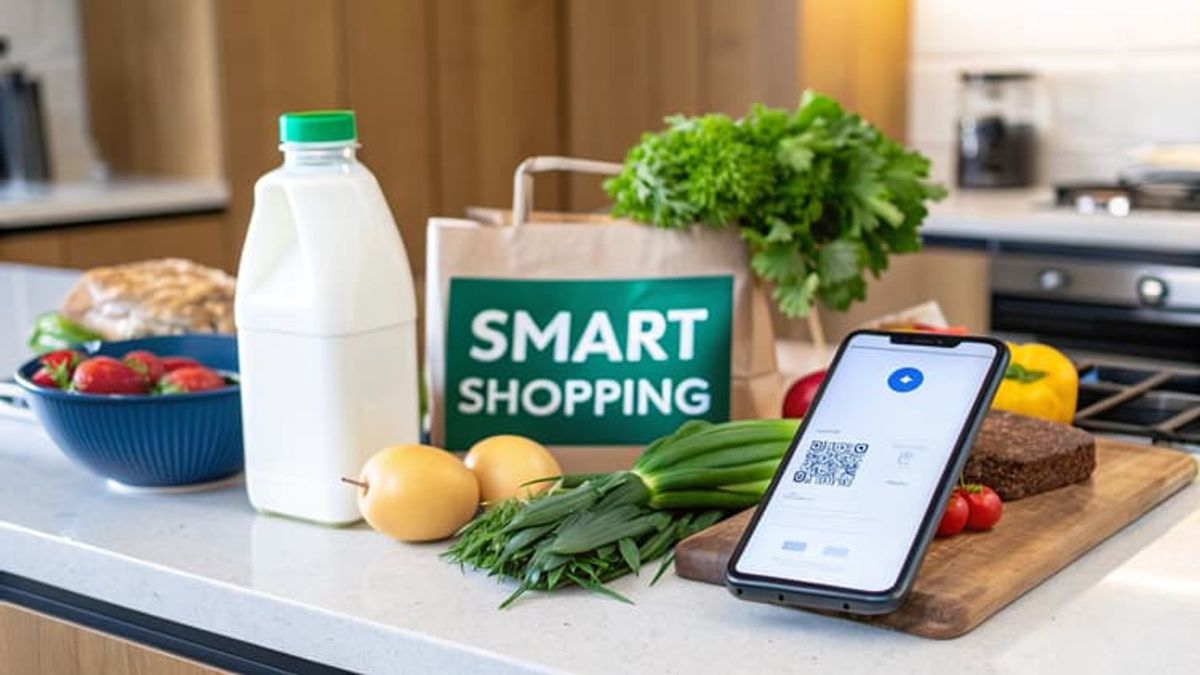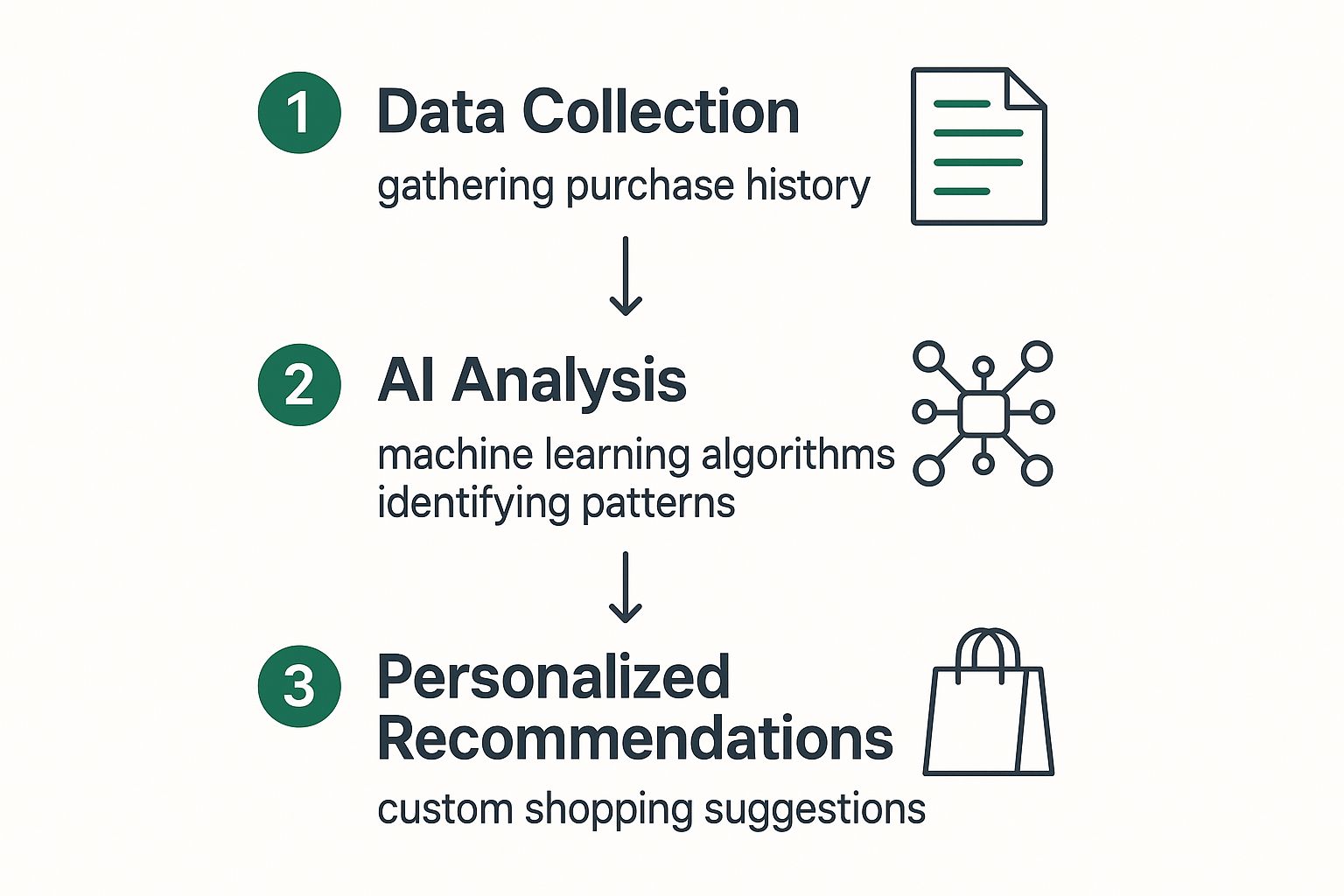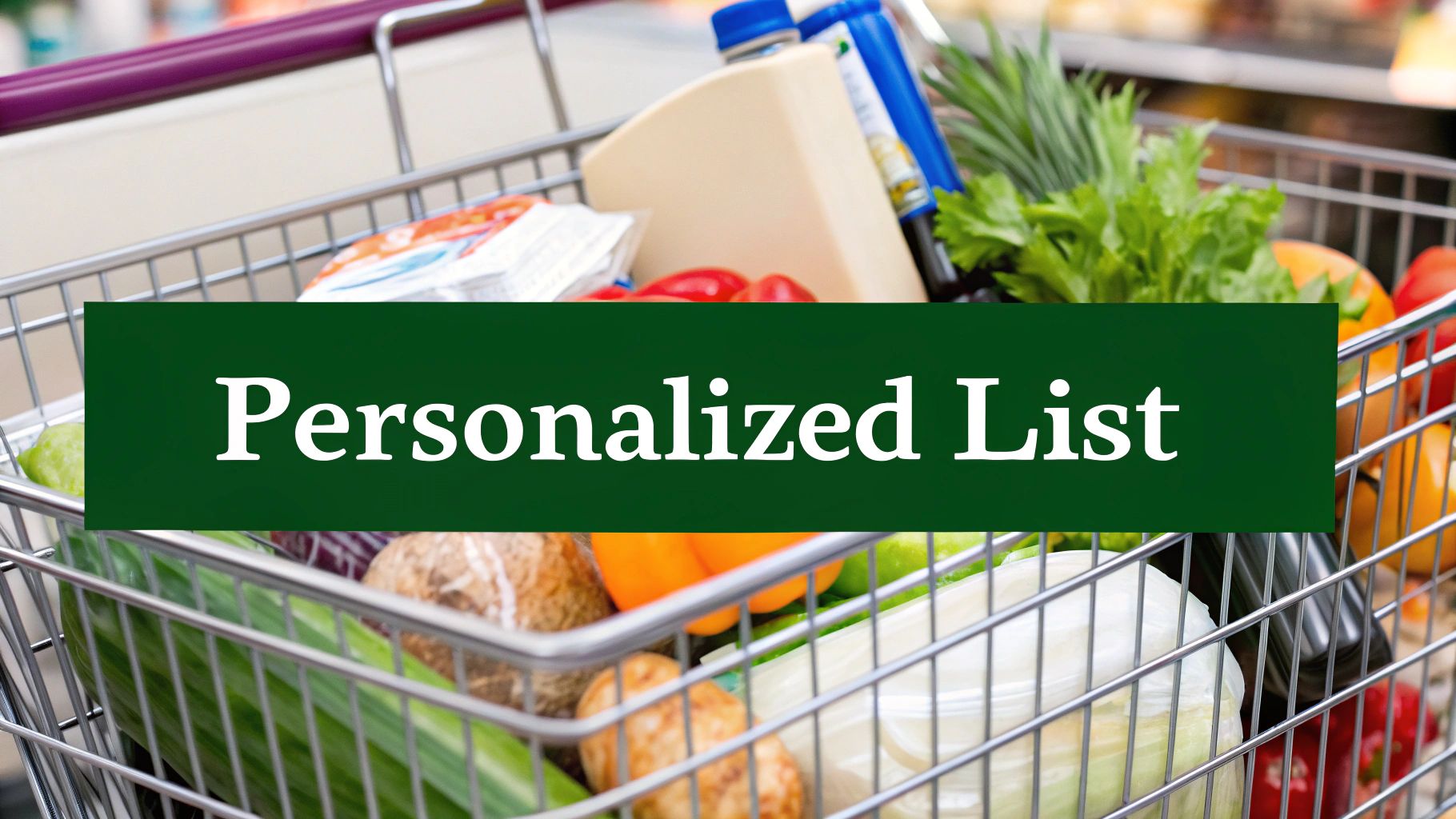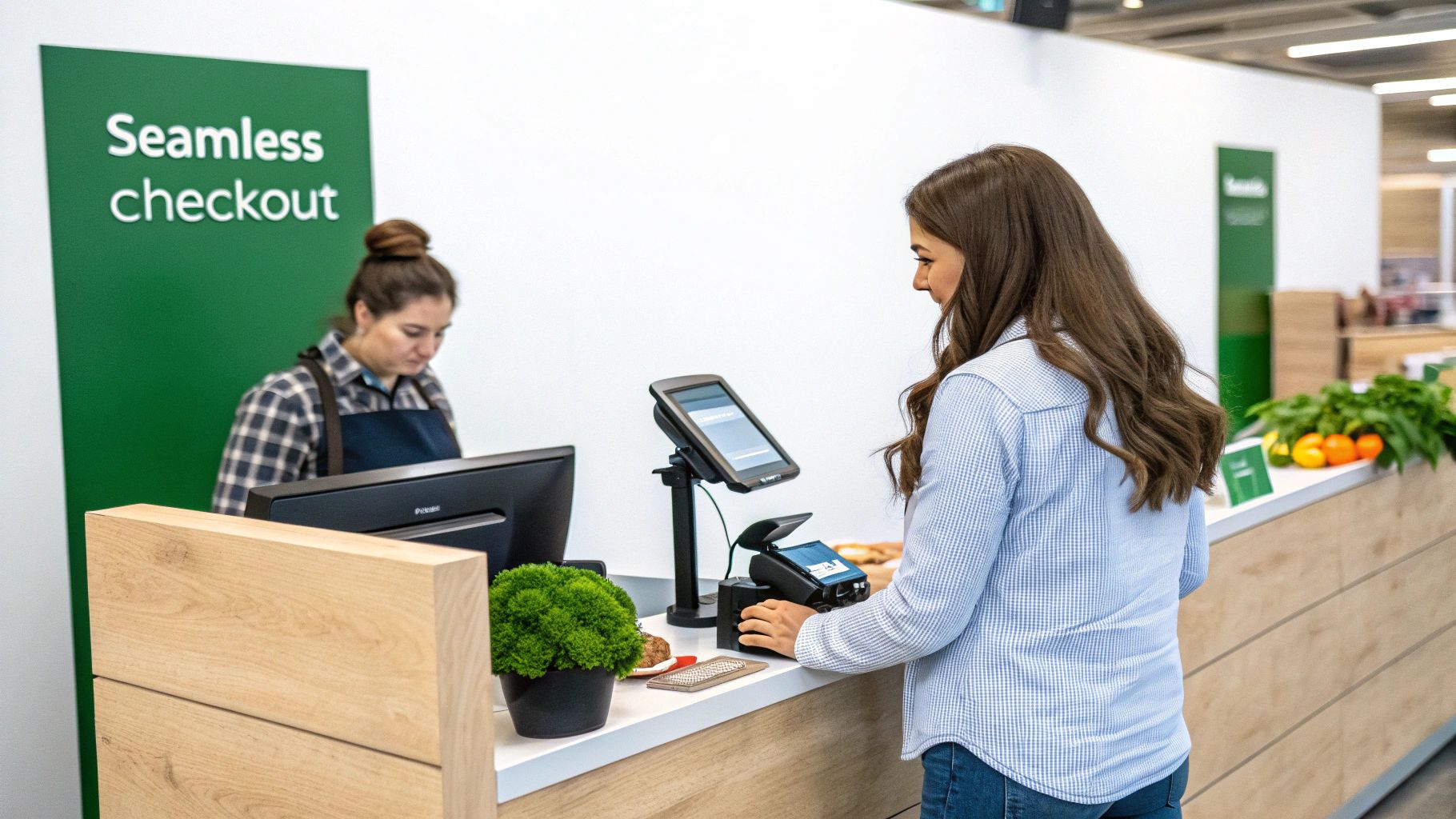Ai Grocery Shopping: Save Time & Money with Smart Planning
Discover how ai grocery shopping simplifies your shopping, cuts waste, and saves you time and money. Transform your kitchen today!
Ready to Simplify Your Meal Planning?
Get personalized meal plans and grocery lists automatically matched to your macro targets.

Ai Grocery Shopping: Save Time & Money with Smart Planning
What if your fridge knew you were low on milk and just ordered more? Or what if your weekly meal plan magically created itself, perfectly tuned to your family’s picky eaters and dietary restrictions? This isn't some far-off fantasy; it's the reality of AI grocery shopping. It’s a clever system that takes one of life's most tedious chores and turns it into a surprisingly slick, hands-off process.
Welcome to Your Future Kitchen

Think of artificial intelligence as your new personal kitchen assistant. This isn't just about a smarter app; it's about a system that actually learns your family's rhythms. It predicts what you’ll need, helps you slash food waste, and, most importantly, gives you back a huge chunk of your time.
So, say goodbye to forgotten ingredients and those frantic, last-minute trips to the store. Let's dig into how AI is making grocery shopping smarter, faster, and—dare I say—actually fun.
The big idea here is beautifully simple. Instead of you carrying the entire mental load of planning meals, checking the pantry, and writing lists, an AI does the heavy lifting. It finally connects the dots between what you want to eat and what you need to buy, closing that frustrating gap that always seems to end in stress or a missing can of tomatoes.
The Old Way vs. The New Way
For as long as we can remember, grocery shopping has been a clunky, manual job. You scribble down a list (if you're organized), trudge through crowded aisles, and cross your fingers that you didn't forget the one thing you really needed. AI grocery shopping throws that entire script out the window. It’s not just a checklist; it’s your proactive sidekick.
Here's a good way to think about it: Traditional shopping is like navigating a new city with a paper map. You'll probably get there, but it's slow and you'll make wrong turns. AI shopping is like having a GPS that not only gives you perfect directions but also reroutes you around traffic jams you didn't even see coming.
This is more than just a little convenience. It’s about building a smarter, more efficient system for your entire household. The AI doesn’t just see that you bought gluten-free pasta once; it figures out why and starts suggesting other products that fit your lifestyle. With over 70% of shoppers having at least one dietary preference, that kind of personal touch is a massive deal.
A Quick Comparison
To really see the difference, it helps to put the old and new ways side-by-side. See how the old way of shopping stacks up against the new AI-powered approach in this quick comparison.
Traditional vs AI Grocery Shopping At a Glance
| Aspect | Traditional Shopping | AI Grocery Shopping |
| List Creation | Manual, based on memory and guesswork. Prone to forgetting things. | Automatically generated from meal plans and what's already in your pantry. |
| Personalization | Limited to what you already know and remember to look for. | Hyper-personalized based on diet, past purchases, and even health goals. |
| Efficiency | Involves time-consuming store trips, wandering aisles, and often a second trip for forgotten items. | The whole process, from planning to delivery, can be done in just a few minutes. |
| Food Waste | Higher risk of buying duplicates or items that go bad before you can use them. | Drastically reduced by suggesting recipes that use ingredients you already have on hand. |
The table really spells it out, doesn't it? One method is stuck in the past, while the other is a genuine leap forward, saving you time, money, and a whole lot of hassle.
How AI Actually Knows You Need More Milk
Ever get that slightly creepy, slightly amazing feeling when your shopping app nudges you about running low on eggs? It’s not a psychic on the payroll; it’s just some seriously clever data science at work. Think of it less like a crystal ball and more like a personal chef who’s memorized all your family's go-to meals, keeps a mental inventory of your pantry, and sniffs out the best deals on your behalf.
This whole operation runs on machine learning, a flavor of AI that gets sharper every time you use it. Each shopping list you make, every item you buy, every recipe you even glance at—it's all a lesson for the AI. It’s not just looking at a single purchase; it's spotting the patterns in your life over weeks and months.
The Brains Behind the List
So, what exactly is this AI looking at? It’s constantly crunching three main types of information to assemble a shopping list that feels like it was read straight from your mind.
- Your Buying Habits: The AI keeps tabs on your essentials. If you grab a gallon of milk every seven days like clockwork, it’s going to flag it on day six, predicting you're about to run out.
- Your Dinner Plans: This is where it gets really cool. When you use a connected app like Meal Flow AI, the system checks your meal plan for the week against what you typically have on hand. It sees your Taco Tuesday recipe calls for sour cream, but it also remembers you bought a fresh tub last week, so it won’t add it to the list.
- Your Little Quirks: The AI pays attention to your choices. If you always swap out the suggested whole wheat bread for sourdough, it’ll catch on. Before long, it will just start recommending sourdough from the get-go.
This powerful trio is the engine that turns a mountain of data into a simple, no-fuss grocery list, making your life just a little bit easier.
From Data Points to Dinner Plans
Watching raw data morph into a perfect recommendation is pretty wild. This visual breaks down how the system scoops up information, hunts for patterns, and serves up suggestions that are tailored just for you.

As you can see, it's a loop of learning and tweaking that makes your AI grocery shopping experience feel almost effortless.
And we're getting used to this kind of smart help. People’s shopping habits are changing, blurring the lines between the physical and digital worlds. In fact, nearly 40% of shoppers now look to AI for help researching products before they even think about buying. You can dive deeper into this "phygital" trend and see how AI is shaking up our expectations in this insightful article about the impact of AI on grocery shopping.
This is what really makes AI different—it's not a static program. It's a living system that evolves with you. The same AI suggesting diapers for your newborn today will be the one recommending after-school snacks a few years down the road.
At the end of the day, the goal is to make shopping feel so personal and seamless that it seems like it was designed only for you. By learning your unique rhythm, the AI can take a weekly chore and turn it into a curated, helpful, and surprisingly simple part of your routine.
So, What's in It for You? The Perks of a Smarter Shopping Cart

Let's be honest, bringing AI into your kitchen isn't just about having the latest gadget. It’s about making a real, noticeable change in your daily life. Families and busy professionals are already catching on, finding that automating this weekly chore gives them some serious wins. Think about it: less food in the bin, more time on your weekends, and actually sticking to your health goals without a daily battle of wills.
These aren't just separate little perks, either. They all work together, creating a domino effect that leads to a much more organized and less frantic existence. The biggest benefits of an AI grocery shopping system boil down to tackling the three things that make feeding ourselves and our families a grind.
Save Your Money
First up, the big one: saving cold, hard cash. AI is your secret weapon against the two worst enemies of your grocery budget—impulse buys and food waste. When your shopping list is built from a solid meal plan, you’re not as tempted to toss that extra bag of cookies or a fancy cheese you don't actually need into the cart. It's just not on the list.
Even better, a smart system knows what you already have. It’s like a frugal grandma, finding recipes that will finally use up that half-eaten jar of pesto or the slightly sad-looking carrots in your crisper drawer. This "pantry-aware" planning is a direct assault on waste. And it's not just us—grocers are getting in on this too. Pilot programs in some supermarkets have already slashed food waste by nearly 15% per store. That's a huge deal when you realize that 30-40% of the food supply in the U.S. often goes uneaten. You can read more about how grocers are using AI to boost efficiency and see the ripple effect it’s causing.
Reclaim Your Time
Time is the one thing we can't buy more of, and the old way of grocery shopping is a notorious time thief. The whole routine—planning meals, writing a list, driving to the store, wandering the aisles, and then unpacking—can suck hours out of your week. An AI-powered system like Meal Flow AI puts that entire process on autopilot.
Picture this: In the time it takes to drink your morning coffee, you tap "approve" on a week's worth of meals, and poof—your grocery list is instantly made and waiting in your Instacart app. The hours you just saved are now yours to do whatever you want with.
This isn't just about moving faster. It's about offloading the mental burden. You no longer have to be the sole keeper of everyone's dietary needs and the master scheduler of meals. The AI handles the nitty-gritty, so you can actually enjoy the fun parts, like cooking and eating.
Eat Healthier Effortlessly
Trying to stick to a healthy eating plan is a constant struggle, especially when you're tired and the thought of cooking makes you want to order a pizza. This is where AI becomes an incredible wellness coach. It’s like having a personal nutritionist who never runs out of ideas, constantly suggesting new and delicious meals that fit your exact needs.
- Customized for You: Whether you're gluten-free, low-carb, or vegan, the AI only shows you recipes that you can actually eat. It filters out all the noise.
- Beats the Boredom: Sick of eating the same three "healthy" meals on repeat? The AI introduces you to a world of new recipes you'll actually get excited about, which makes sticking to your plan sustainable.
- Willpower Not Required: Suddenly, the healthiest choice is also the easiest one. When your fridge is stocked for delicious, pre-planned meals, the temptation for last-minute junk food just melts away.
Create Your Perfect AI Meal Workflow
Alright, this is where things get really cool. We're moving beyond just a smart list and into a full-blown automated system where your meal plan and grocery list are best friends. This is the moment they team up to eliminate all the annoying little tasks that stand between you and a delicious, home-cooked meal.
Think about it. No more frantic pantry checks, no more scribbled notes on the back of an envelope, and definitely no more "Wait, what was that recipe again?" This is about making the entire process feel like one smooth, simple motion.
Picture this: you're using an app like Meal Flow AI to map out your dinners for the week. Once you've picked a few recipes your family will actually eat, the AI gets to work. It's not just spitting out a generic list of ingredients. Instead, it peeks into your digital pantry, sees what you've already got, and builds a shopping list with surgical precision. This isn’t just a smarter to-do list; it’s your entire kitchen running on autopilot.
Connecting Your Plan to Your Cart
The real genius here is the unbreakable link between planning your meals and actually buying the food. We've always treated these as two separate, often painful, chores. The AI smashes them together into one fluid workflow. This connection is what transforms a neat convenience into true automation, with a system that knows what you need before you do.
Let’s walk through how this plays out in real life:
- Meal Selection: You tap "Chicken Stir-fry" for Wednesday and "Spaghetti Bolognese" for Friday from a list of tasty suggestions.
- Pantry Cross-Check: The AI remembers that giant bottle of soy sauce you bought last week and leaves it off the list. But it also sees you're down to the last handful of spaghetti noodles, so it adds a new box.
- List Generation: A perfectly complete shopping list pops up in seconds, containing only the items you actually need for the week.
- Effortless Ordering: With another tap, that list is zapped over to a service like Instacart, queued up, and ready for delivery.
Think of this integrated system as the world's most efficient kitchen manager. It doesn't just know what you want to cook—it knows what you already have. This means no wasted food and no forgotten ingredients. It's the ultimate cure for those "Drat, I forgot the onions!" moments.
A Workflow That Learns You
This system isn't just a one-trick pony; it gets smarter with every single use. The real magic is how the AI pays attention to your habits.
Let's say you always swap ground beef for ground turkey when you make that Bolognese. The system notices. After a few times, platforms like Instacart’s Smart Shop will start suggesting ground turkey right from the get-go. It’s constantly refining its suggestions to fit how you really cook and eat.
With more than 70% of shoppers managing at least one dietary need—from gluten-free to low-carb—this kind of smart personalization is a game-changer. The AI workflow handles all that complexity behind the scenes. It cuts through the noise and shows you what works for you, making the overwhelming task of grocery shopping feel like a simple, curated experience that’s perfectly in sync with your life.
How Smart Shopping Heals Our Planet

When you opt for AI grocery shopping, you’re doing a lot more than just making your life easier. You're actually sending a positive ripple out into the world. It’s a pretty cool thought—this smart tech is not just upgrading our kitchens, but it's also helping heal the entire food supply chain, one intelligently planned meal at a time.
The impact starts right where you'd expect: the grocery store.
Retailers are using powerful predictive analytics to get a crystal-clear picture of what we’re all going to buy. This helps them slash overstocking, which is one of the biggest culprits behind food waste. Less wasted food on store shelves means fresher produce for you, healthier profits for them, and a massive win for the planet. It’s a cycle where everybody comes out ahead.
Trimming the Fat from Farm to Table
Zooming out from the store, AI is also busy untangling the ridiculously complex journey food takes to get from the farm to your fridge. If the traditional supply chain is a messy highway full of traffic jams, think of AI as the world’s most brilliant traffic control system, finding the perfect route for every single delivery.
What does that mean in the real world? Fewer trucks clogging up the roads, smarter shipping routes, and a serious drop in your groceries' carbon footprint. Your simple choice to use a service like Meal Flow AI plugs you directly into this bigger, greener movement.
Here’s a glimpse at how retailers are already putting AI to work to get more efficient.

As you can see, AI is quickly graduating from small experiments to being a core part of the business, with major chains using it for everything from managing stock to improving how we shop.
A Greener Industry and a Smarter You
The motivation here is huge, both financially and environmentally, which is why the grocery industry is jumping into AI with both feet. The tech is on track to create an estimated $136 billion in global value by 2030. For example, BJ’s Wholesale Club has deployed AI-powered robots to scan shelves for real-time inventory data, helping staff know exactly what to restock and when. You can dive deeper into how AI is transforming the grocery business to see just how big this shift is.
By tackling waste at both the corporate and household levels, AI creates a powerful one-two punch for sustainability. Retailers cut down on mass spoilage, while you eliminate waste in your own kitchen.
At the end of the day, your personal shopping habits are a small but crucial piece of this massive positive change. Every time you plan your meals with AI and buy only what you truly need, you’re casting a vote for a more efficient, less wasteful world.
Ready to Give AI Grocery Shopping a Go?
Alright, let's dive in. Getting started with AI grocery shopping isn't some complex tech project. You don't need a degree in robotics or a home full of smart gadgets. It really just comes down to picking the right app and letting it handle the heavy lifting.
Think of it like choosing your mission control. Sure, a lot of standard grocery store apps have some "smart" features baked in, but a dedicated platform like Meal Flow AI is designed to run the whole show. You want an app that ties everything together—your meal plans, what's already in your pantry, and a direct link to a delivery service like Instacart. That's where the real magic happens.
Getting to Know Your AI Butler
Once you've picked your app, the fun part starts. This is the "getting to know you" phase. Your new AI assistant is a blank slate, and every little thing you do helps it learn your tastes. The more you interact with it, the sharper it gets.
Kick things off by plugging in your family's go-to meals, any allergies, or dietary preferences. Many of these apps, especially those using Instacart's Smart Shop AI, will actively ask for your input. You might get a little pop-up that says, "Show more low-carb options?" Answering these questions helps the AI narrow down what you actually want to see.
It’s a bit like training a personal shopper. The first few times, you have to be super specific—"No, I want oat milk, not almond." But before you know it, they’re grabbing your favorite brand without you even having to ask.
The One-Week Challenge: Your First Mission
Want to get the hang of it fast? Try this simple one-week challenge. It’s the perfect way to see the benefits firsthand and build some confidence.
- Day 1 - Plan & Deploy: Fire up your app and pick just three easy recipes for the week. Let the app generate your first AI grocery shopping list and send it straight to your delivery service.
- Day 3 - Cook & Correct: Time to make that first meal. Did you have everything you needed? If you had to swap out an ingredient, make a quick note of it in the app. The AI is paying attention!
- Day 7 - The Debrief: Look back at your week. How much time did you actually save? Did you find it easier to stick to your meal plan? Seeing those early wins is often the best fuel to keep going.
This isn't about getting it perfect on the first try. It’s just about taking one small, easy step toward a kitchen that feels less chaotic and more in your control. You've got this.
Got Questions About AI Groceries? We've Got Answers.
Diving into the world of AI grocery shopping feels a bit like stepping into the future, right? It's exciting, but it’s totally normal to have a few questions buzzing around. Will it cost a fortune? What about my privacy? And does this mean I have to say goodbye to my therapeutic strolls through the produce aisle?
Let's cut through the noise and tackle the big questions head-on. A lot of folks worry that bringing AI into the kitchen means losing control or giving up their favorite shopping habits. The reality? It’s not a takeover; it’s a team-up.
So, Does This Mean I Can Never Set Foot in a Grocery Store Again?
Only if you want to hang up your cart for good! AI shopping is all about options and flexibility. If you love the convenience of having everything delivered to your doorstep, it can automate your entire online order. Done.
But if you genuinely enjoy picking out your own avocados, it can simply act as your super-powered assistant. Imagine having the perfect shopping list, magically organized by aisle, turning your usual hour-long trek into a 20-minute blitz. You're always in control—it just makes whatever you choose to do way more efficient.
Is My Personal Data Actually Safe?
This is a big one, and rightly so. Reputable AI platforms take your privacy very seriously. They use beefy encryption and have straightforward privacy policies that spell out exactly how your data is handled. Generally, your shopping history is anonymized and used to make the AI smarter for everyone, not to spy on your secret late-night ice cream habit.
Here's a solid rule of thumb: before signing up for anything, give the privacy policy a quick scan. Stick with well-known, trusted services. Your peace of mind is worth it.
What's the Real Cost? Am I Going to Go Broke?
You'd be surprised. Many of these smart features are already baked into the free apps from major grocery chains like Kroger or Walmart. For more advanced, all-in-one platforms that handle meal planning and more, there might be a small monthly subscription.
But here’s the kicker: most people find they actually save money. When your shopping list is perfectly aligned with your meal plan, you all but eliminate food waste. Plus, you sidestep all those tempting impulse buys that somehow jump into your cart. The service often pays for itself in just a few weeks.
---
Ready to see what an automated kitchen feels like? Meal Flow AI syncs up with your go-to grocery services, turning your meal plans into perfectly crafted shopping lists in a snap. Start your free trial and experience an effortless kitchen today!